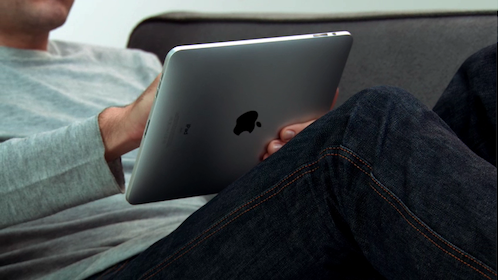Of all the images to come out of the iPad announcement, the one struck me the most was less about the device and more about the experience of it:

Lying back on the sofa — isn’t that a nice way to be?
And sitting or lying on the sofa with a 9.7 inch screen means we’ll typically hold this about 2 feet (.6 meter) away from our eyes, versus 1 foot with an iPhone, which means you can rest it on your lap. While some may buy the dock, putting the iPad on a surface means having to uncomfortably lean over it. I think lounging will be much more common. We can do this with a laptop, but the separation of output (display) and input (keyboard and trackpad) is disjointed in comparison. And the iPad will be a little awkward and heavy to hold aloft like a phone.
Consequently the mood while interacting with an iPad may be more relaxed. The interaction has the potential to be more passive, though not necessarily. We’ll make bigger gestures and pivot at the elbow and shoulder rather than the wrist. We’ll scroll/size less than on a phone, using more eye movement to scan the screen. And while Apple has had to succumb to menus to make more functions available, we have the potential for powerful new forms of direct manipulation.
As a designer I’m tempted to display more, denser visual content at one time that a person can sit back and absorb, and offer control with fewer, grander gestures.
Given the physical similarity, it’s tempting to look at the iPad and call it a big iPhone. But I think the posture we adopt and interaction with the device will make it an experience unlike a phone or a laptop.
Aside: how long until someone designs a lounge chair specifically for optimal iPad use?!







